 W
WThe Acclaim Remote Controller is a third party wireless game controller developed by Acclaim Entertainment Inc for the Nintendo Entertainment System (NES) in 1989. This accessory used standard IR signals, commonly found in other remote controls of the time, to send button inputs from the wireless control pad to a receiver plugged into a controller port on the console.
 W
WAn arcade controller is a collective set of input devices designed primarily for use in an arcade cabinet. A typical control set consists of a joystick and a number of push-buttons. Less common setups include devices such as trackballs or steering wheels. These devices are generally produced under the assumption that they will be used in commercial settings, such as in video arcades, where they may be heavily or roughly used. Durability is one of the distinguishing characteristics of "authentic" arcade parts when compared with numerous, low-cost arcade imitations designed for private use in the home.
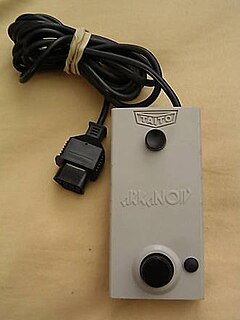 W
WThe Arkanoid Controller, or Vaus, is an optional game controller for the Nintendo Entertainment System (NES) and MSX game Arkanoid which enhances the feel and play of the game.
 W
WThe Atari joystick port is a computer port used to connect various gaming controllers to game console and home computer systems in the 1970s to the 1990s. It was originally introduced on the Atari 2600 in 1977 and then used on the Atari 400 and 800 in 1979. It went cross-platform with the Commodore VIC-20 of 1981, and was then used on many following machines from both companies, as well as a growing list of 3rd party machines like the MSX platform and various Sega consoles.
 W
WThe Atari Mindlink is an unreleased video game controller for the Atari 2600, originally intended for release in 1984. The Mindlink was unique in that its headband form factor controls the game by reading the myoneural signal voltage from the player's forehead. The player's forehead movements are read by infrared sensors and transferred as movement in the game.
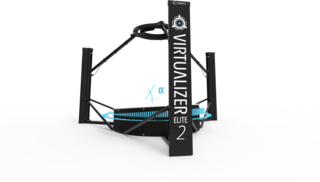 W
WThe Virtualizer is a series of omnidirectional treadmills with integrated sensors for motion detection in virtual reality applications. The products are being developed, manufactured and sold by the Austrian company Cyberith GmbH.
 W
WA D-pad is a flat, usually thumb-operated, often digital, four-way directional control with one button on each point, found on nearly all modern video game console gamepads, game controllers, on the remote control units of some television and DVD players, and smart phones. Like early video game joysticks, the vast majority of D-pads are digital; in other words, only the directions provided on the D-pad buttons can be used, with no intermediate values. However, combinations of two directions do provide diagonals and many modern D-pads can be used to provide eight-directional input if appropriate.
 W
WA dance pad, also known as a dance mat or dance platform, is a flat electronic game controller used for input in dance games. Most dance pads are divided into a 3×3 matrix of square panels for the player to stand on, with some or all of the panels corresponding to directions or actions within the game. Some dance pads also have extra buttons outside the main stepping area, such as "Start" and "Select". Pairs of dance pads often are joined, side by side, for certain gameplay modes.
 W
WThe Dual Analog Controller is Sony's first handheld analog controller for the PlayStation, and the predecessor to the DualShock. Its first official analog controller was the PlayStation Analog Joystick (SCPH-1110).
 W
WFreeTrack is a general-purpose optical motion tracking application for Microsoft Windows, released under the GNU General Public License, that can be used with common inexpensive cameras. Its primary focus is head tracking with uses in virtual reality, simulation, video games, 3D modeling, computer aided design and general hands-free computing to improve computer accessibility. Tracking can be made sensitive enough that only small head movements are required so that the user's eyes never leave the screen.
 W
WThe game port, originally introduced on the Game Control Adapter, is a device port that was found on IBM PC compatible and other computer systems throughout the 1980s and 1990s. It was the traditional connector for joystick input, and occasionally MIDI devices, until phased out by USB in the late 1990s.
 W
WThe GameCube controller is the standard game controller for the GameCube home video game console, manufactured by Nintendo and launched in 2001. As the successor to the Nintendo 64 controller, it is the progression of Nintendo's controller design in numerous ways. The contentious M-shaped design of its predecessor was replaced with a more conventional handlebar style controller shape; a second analog stick was added, replacing the C buttons with a C stick and the X and Y face buttons, last seen on the Super Nintendo controller, were reintroduced; the shoulder buttons were changed to hybrid analog triggers. A wireless variant of the GameCube controller known as the WaveBird was released in 2002.
 W
WA gamepad, joystick, controller, is a type of game controller held in two hands, where the fingers are used to provide input. They are typically the main input device for video game consoles.
 W
WThe Gravis PC GamePad is a game port game controller produced by Advanced Gravis Computer Technology first released in 1991. It was the first gamepad for the IBM PC compatible in a market then dominated by joysticks. Included with the gamepad was a shareware Commander Keen game, episode 1, Marooned on Mars, which was later replaced with the shareware episode 4, Secret of the Oracle which supported all 4 buttons. The gamepad is no longer manufactured, as Gravis was acquired in 1997 by Kensington Computer Products Group.
 W
WGreen Throttle Games is a video game and video game peripheral developer.
 W
WA guitar controller is a video game controller designed to simulate the playing of the guitar, a string musical instrument. Guitar controllers are often used for music games such as UmJammer Lammy: NOW!, GuitarFreaks, Guitar Hero, and the Rock Band series. The controllers are played by holding down a colored fret button that matches a colored, on-screen note, while pressing the strum bar as the note passes through the target. The controllers also feature a whammy bar, which is used to bend notes and collect each game's equivalent of bonus energy. Different games and models of controllers have introduced additional features, such as effects switches, additional fret buttons, and fret touch pads. The fret buttons are colored usually in the order of green, red, yellow, blue, and orange.
 W
WHaptic technology, also known as kinaesthetic communication or 3D touch, refers to any technology that can create an experience of touch by applying forces, vibrations, or motions to the user. These technologies can be used to create virtual objects in a computer simulation, to control virtual objects, and to enhance remote control of machines and devices (telerobotics). Haptic devices may incorporate tactile sensors that measure forces exerted by the user on the interface. The word haptic, from the Greek: ἁπτικός (haptikos), means "tactile, pertaining to the sense of touch". Simple haptic devices are common in the form of game controllers, joysticks, and steering wheels.
 W
WThe iCade is an accessory for the Apple iPad line of devices which functions as a miniaturised, portable arcade cabinet, including a physical joystick and buttons. The iPad is inserted into the iCade and connects to the device using Bluetooth, allowing it to be used as an arcade-style controller for compatible games.
 W
WThe iControlPad is a wireless game controller compatible with a variety of smartphones, tablets, and personal computers. It is designed for use as either a standalone gamepad or attached to appropriately sized devices, such as the iPhone, using a clamp system. Due to this, the iControlPad is able to add traditional physical gaming controls to devices which otherwise rely on inputs such as touchscreens and accelerometers.
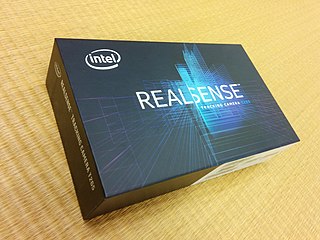 W
WIntel RealSense Technology is a product range of depth and tracking technologies designed to give machines and devices depth perceptions capabilities. The technology, owned by Intel are used in autonomous drones, robots, AR/VR, smart home devices amongst many others broad market products.
 W
WInfrared Control Freak 360 (IRCF360) is a 360 degree proximity sensor and a motion sensing devices, developed by ROBOTmaker. The sensor is in BETA developers release as a low cost sensor for use within research, technical and hobby projects.
 W
WThe Jogcon is a controller developed and produced by Namco for the Sony PlayStation videogame console.
The Joyboard is a balance board peripheral for the Atari 2600 video game console. It was released in 1982 and was used by standing on top of it and leaning in a certain direction. Skier Suzy Chaffee appeared on television and at toy fairs demonstrating its use.
 W
WA joystick is an input device consisting of a stick that pivots on a base and reports its angle or direction to the device it is controlling. A joystick, also known as the control column, is the principal control device in the cockpit of many civilian and military aircraft, either as a centre stick or side-stick. It often has supplementary switches to control various aspects of the aircraft's flight.
 W
WKinect is a line of motion sensing input devices produced by Microsoft and first released in 2010. The technology includes a set of hardware originally developed by PrimeSense, incorporating RGB cameras, infrared projectors and detectors that mapped depth through either structured light or time of flight calculations, and a microphone array, along with software and artificial intelligence from Microsoft to allow the device to perform real-time gesture recognition, speech recognition and body skeletal detection for up to four people, among other capabilities. This enables Kinect to be used as a hands-free natural user interface device to interact with a computer system. Kinect is a peripheral that sits atop the user's display similar to a webcam.
 W
WThe Logitech Driving Force GT is a racing wheel peripheral designed for racing games on the PlayStation 2, PlayStation 3, and Windows PCs. It is manufactured and distributed by Logitech International S.A of Romanel-sur-Morges, Switzerland. The wheel was released on December 13, 2007.
 W
WThe Logitech G29 is a racing wheel made by Logitech. It supports PlayStation 4, PlayStation 3 and PC. The Logitech G920 is its counterpart compatible with Xbox One and PC, with different buttons and logos. It replaced the Logitech G27 in 2015, but retains the internal design and technical specifications.
 W
WThe Magnum Light Phaser is a light gun created in 1987 for the ZX Spectrum computer. A version was also released for the Commodore 64/128. It was Amstrad's last peripheral for the video game console. The Magnum Light Phaser in many ways resembles the Light Phaser, the Sega Master System light gun, released in 1986. It was a Sinclair-branded Far Eastern product which was included in promotional bundles such as the "James Bond 007 Action Pack", along with a small number of lightgun-compatible games.
 W
WMicrosoft SideWinder was the general name given to the family of digital game controllers developed by Microsoft for PCs. The line was first launched in 1995. Although intended only for use with Microsoft Windows, Microsoft SideWinder game controllers can also be used with macOS, Mac OS 9 with third-party software, and Linux.
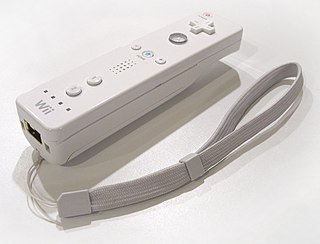 W
WIn video games and entertainment systems, a motion controller is a type of game controller that uses accelerometers or other sensors to track motion and provide input.
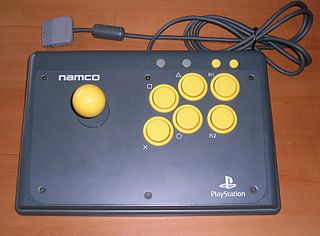 W
WThe Namco Arcade Stick is a joystick video game controller released by Namco in 1996 for the PlayStation.
 W
WThe NeGcon, stylized as neGcon, is a motion-based video game controller manufactured in 1995 by Namco for the PlayStation. One of the first third-party peripherals for the system, the controller is connected by a swivel joint, allowing the player to twist the halves relative to each other. The controller also replaces the “symbol” buttons on the original PlayStation controller with two “A” and “B” buttons, as well as “I” and “II” buttons that allowed for analogue control. A black variant was released exclusively in Japan.
 W
WThe Nintendo 64 controller is the standard game controller for the Nintendo 64 home video game console. Manufactured and released by Nintendo on June 23, 1996 in Japan, in late 1996 in North America, and 1997 in Europe. It is the successor to the Super Nintendo controller and is designed in an "M" shape and features 10 buttons, one analog "Control Stick" and a directional pad.
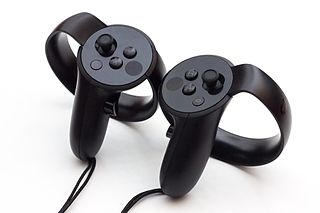 W
WOculus Touch is the motion controller system used by Oculus VR in their Rift, Rift S, and Quest virtual reality systems. Three iterations of the controllers have been developed; the first for use in the original Oculus Rift, which uses external tracking, and the second one for use with the Rift S and the Oculus Quest, which use inside-out tracking, and the third being a sort of mixture between the two, soon to be released for the Quest 2.
 W
WA paddle is a game controller with a round wheel and one or more fire buttons, where the wheel is typically used to control movement of the player object along one axis of the video screen. A paddle controller rotates through a fixed arc ; it has a stop at each end.
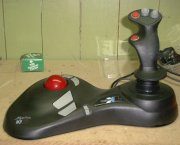 W
WThe Panther XL by Mad Catz is a joystick and trackball combination that is used to replace the keyboard and mouse for player movement in first-person shooter games like Quake and Unreal. it could also be used for flight simulators so players can point their ship in any direction with the trackball. Based on a patent by James Barnes of First-Person Gaming, the Panther XL used technology used in the Assassin 3D controller.
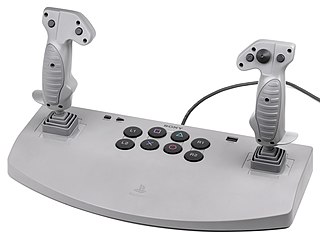 W
WThe PlayStation Analog Joystick (SCPH-1110) is Sony's first analog controller for the PlayStation, and is the precursor to the PlayStation Dual Analog Controller. It is often incorrectly referred to as the "Sony Flightstick".
 W
WThe PlayStation controller is the first gamepad released by Sony Computer Entertainment for its PlayStation home video game console. The original version was released alongside the PlayStation on December 3, 1994.
 W
WThe PlayStation Mouse is an input device for the PlayStation that allows the player to use a mouse as a method of control in compatible games. The mouse was released in Japan on December 3, 1994, the launch date of the PlayStation.
 W
WPlayStation Move is a motion game controller developed by Sony Computer Entertainment. Initially released in 2010 for use with the PlayStation 3 video game console, its compatibility was later expanded to its successor, the PlayStation 4, in 2013, its PlayStation VR platform in 2016 and the PlayStation 5 in 2020. Conceptually similar to Nintendo's Wii Remote and Microsoft's Kinect, its function is based around controller input in games stemming from the actual physical movement of the player. The Move uses inertial sensors in the wand to detect motion while the wand's position is tracked using a PlayStation Eye or PlayStation Camera. The device was generally well-received by critics, but has not quite met Sony's goals for integration into the market.
 W
WThe Power Glove is a controller accessory for the Nintendo Entertainment System. The Power Glove gained public attention due to its early virtual reality mechanics and significant marketing. However, its two games did not sell well, as it was not packaged with a game, and it was criticized for its imprecise and difficult-to-use controls.
 W
WThe Powerplay Cruiser was a joystick released in 1986, during the time that the Commodore 64 and Commodore Amiga were both popular home computers. It was compatible with many 8-bit and 16-bit machines, and boasted many features that were considered high end at the time:Fully microswitch-based operation 8-directional control Ambidextrous design Adjustable torque control Rugged plastic body & sturdy, long-lasting design Available in a range of colours/models : All Black Blue body, red stick, white fire buttons Pastel green body, with pastel yellow fire buttons, pastel pink joystick shaft and pastel blue torque controller Transparent body, black stick and buttons featuring a rare autofire working-type, as it operates automatically when any of the 2 buttons is held down The black and red Cruiser Turbo, featuring an autofire facility(the pastel version was arguably the most popular, matching the fashions of the era, followed by the sleek black model)
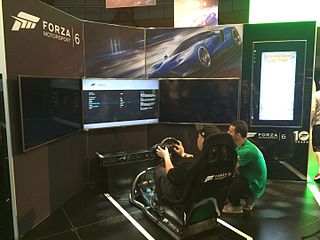 W
WA racing wheel is a method of control for use in racing video games, racing simulators, and driving simulators. They are usually packaged with a large paddle styled as a steering wheel, along with a set of pedals for gas, brake, and sometimes clutch actuation, as well as various shifter controls. An analog wheel and pedal set such as this allows the user to accurately manipulate steering angle and pedal control that is required to properly manage a simulated car, as opposed to digital control such as a keyboard. The relatively large range of motion further allows the user to more accurately apply the controls. Racing wheels have been developed for use with arcade games, game consoles, personal computers, and also for professional driving simulators for race drivers.
 W
WSixaxis is a wireless gamepad produced by Sony for their PlayStation 3 video game console. It was introduced alongside the PlayStation 3 in 2006 and remained the console's official controller until 2008. The Sixaxis was succeeded by the DualShock 3, an updated version of the controller that, like the DualShock and DualShock 2 controllers, incorporates haptic technology – also known as force feedback. A Sixaxis controller can also be used with Sony's PSP Go via Bluetooth after registering the controller on a PlayStation 3 console.
 W
WThe Smash Box controller is a custom arcade controller designed by Dustin Huffer and developed by Hit Box from 2014 to 2017. Specifically designed for competitive play of Super Smash Bros. Melee, the Smash Box controller replaces the GameCube controller's analog stick with a button layout. This controller may allow more precise and rapid input, though it has a steeper learning curve than the traditional controller. Moreover, the Smash Box controller may have various health benefits, as it puts less stress on the hands of its user. After a "test period" of half a year, various prominent tournament organizers have decided that the use of the Smash Box controller and similar alternative controllers are not legal in high-level tournaments for the foreseeable future.
 W
WThe Steam Controller is a game controller developed by Valve for use with personal computers running Steam on Windows, macOS, Linux, smartphones or SteamOS. The controller was designed not only for games developed for controller users, but also for games traditionally played with keyboard and mouse controls so that they can be played through the controller. It was released in November 2015 to support Valve's Steam Machine and discontinued in November 2019.
 W
WThe Super Controller is an accessory for the Nintendo Entertainment System video game console. It was released by Bandai and was a plastic clip-on device that was supposed to allow the player to have a better NES playing experience. The original NES controller could be inserted inside by snapping open the back. The Super Controller still allowed the player to use the original A, B, Start, and Select buttons on the NES controller; the only difference was an arcade stick-like knob that fit over the D-pad of the original NES controller.
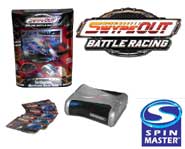 W
WSwypeout Battle Racing, or simply Swypeout, was an online personal computer game produced by Spin Master that was released in 2007. On January 1, 2009 the Swypeout Battle Racing online service was closed.
 W
WA trackball is a pointing device consisting of a ball held by a socket containing sensors to detect a rotation of the ball about two axes—like an upside-down mouse with an exposed protruding ball. Users roll the ball to position the on-screen pointer, using their thumb, fingers, or commonly the palm of the hand while using the fingertips to press the mouse buttons.
 W
WTrackIR is an optical motion tracking game controller for Microsoft Windows created by NaturalPoint Inc.. TrackIR tracks head motions with up to six degrees of freedom (6DOF) in later models, allowing handsfree view control for improved game immersiveness and situational awareness. Head position and orientation are measured by a purpose-built video camera, mounted on top of the user's monitor, which observes invisible infrared (IR) light reflected or emitted by markers on a rigid model worn by the user. TrackIR software is used to access and control the camera, as well as adjust tracking and manage game profiles. The ratio of actual head movement to virtual head movement can be changed, allowing the virtual head to turn 180 degrees whilst the user still looks at the monitor.
 W
WThe Virtuix Omni is an omnidirectional treadmill simulator for virtual reality games and other applications. It uses a platform to simulate locomotion i.e. the motion of walking, requiring both special shoes or shoe covers and a surface that reduces friction. It works in conjunction with the HTC Vive, and allows a vive user to walk within a limited number of games.
 W
WA wired glove is an input device for human–computer interaction worn like a glove.
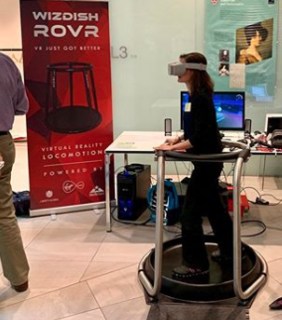 W
WThe Wizdish ROVR is an omnidirectional treadmill that simulates walking and running in virtual reality when used alongside a head-mounted display.
 W
WWonderbook is an augmented reality peripheral for the PlayStation 3 console. The user holds a physical book-like object and stories come to life as the software displays content on the television's screen.
 W
WThe Xbox 360 controller is the primary game controller for Microsoft's Xbox 360 home video game console that was introduced at E3 2005. The Xbox 360 controller comes in both wired and wireless versions. The Xbox controller is not compatible with the Xbox 360. The wired and wireless versions are also compatible with Microsoft PC operating systems, such as Windows XP, Windows Vista, Windows 7, Windows 8, and Windows 10.
 W
WThe Xbox Adaptive Controller is a video game controller designed by Microsoft for Windows PCs and the Xbox One video game console. The controller was designed for people with disabilities to help make user input for video games more accessible.
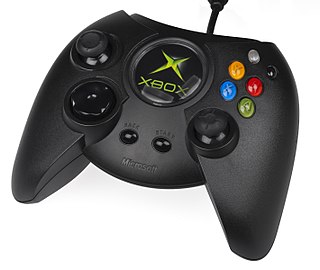 W
WThe Xbox controller is the primary game controller for Microsoft's Xbox home video game console and was introduced at the Game Developers Conference in 2000. The first-generation Xbox controller was the first controller bundled with Xbox systems for all territories except Japan. A smaller and redesigned variant, called "Controller S", was sold and bundled with the console in Japan. It was later released in other territories and by the end of 2003 had replaced the first-generation controller worldwide. The larger original controller remained available as an optional accessory.
 W
WThe Xbox Wireless Controller is the primary game controller for the Xbox One and Xbox Series X/S home video game consoles, also commercialized for its use in Windows-based PCs, and compatible with other operating systems such as macOS, Linux, iOS and Android. The controller maintains the overall layout found in the Xbox 360 controller, but with various tweaks to its design, such as a revised shape, redesigned analog sticks, shoulder buttons, and triggers, along with new rumble motors within the triggers to allow for directional haptic feedback.